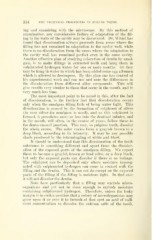Page 644 - My FlipBook
P. 644
314 THE TECHNICAL PKOCEDTJEES IN FILLING TEETH.
ing and examining with the microscope. By this method of
examination, any considerable failure of adaptation of the fill-
ing to the walls of the cavity may be discovered. Dr. Witzel has
found that discoloration always proceeds from areas where the
filling has not remained in adaptation to the cavity wall, while
there is no discoloration from the areas where the adaptation to
the cavity wall has remained perfect even in the same cavity.
Another effective plan of studying coloration of dentin by amal-
gam, is to make fillings in extracted teeth and hang them in
sulphureted hydrogen water for one or more months. Or they
may be himg in water to which has been added some egg albumen
which is allowed to decompose. By this plan one has control of
his experimental work and can use and note the differences in
the discoloration from different alloy compounds. This will
give results very similar to those that occur in the mouth, and in
very much less time.
The most important point to be noted in this, after the fact
of discoloration, is the further fact that discoloration occurs
onlj' when the amalgam filling fails of being water tight. This
discoloration is caused by the formation of sulphuret of silver
(in case silver-tin amalgam is used), and as this sulphuret is
formed, it percolates more or less into the dentinal tubules, and
in the mouth, will often, in the course of years, follow these to
the dento-enamel junction. This may, in pulpless teeth, discolor
the whole crown. The color varies from a grayish brown to a
deep black, according to its intensity. It may be any possible
shade produced by the intermingling of white and black.
It should be understood that this discoloration of the tooth
substance is something different and apart from the discolor-
ation of the exposed parts of the amalgam filling. We expect
these to become a grayish brown or lead color, or a deep black,
but only the exposed parts can discolor if there is no leakage.
The sulphuret can be deposited only where moisture impreg-
nated with sulphureted hydrogen can come in contact with the
filling and the dentin. This it can not do except on the exposed
parts of the filling if the filling is moisture tight. In that case
it will not discolor the dentin.
Note here particularly that a filling may exclude micro-
organisms and yet not be close enough to exclude moisture
containing sulphureted hydrogen. Therefore, unless the leaky
margin is in such a position that a colony of microorganisms may
grow upon it or over it to furnish at that spot an acid of suffi-
cient concentration to dissolve the calcium salts of the tooth,


